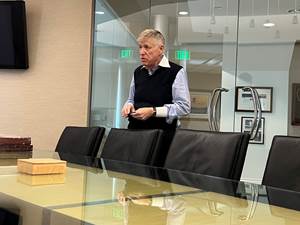Novel Additives Lift the Fog
Kafrit has new developments in anti-fog technology for PETG, nylon, PLA for agricultural and packaging film and sheet.
Significant changes in the chemistry of additives for plastics typically take years to develop and when unveiled are often likely to be game changers. That may well be the case with the latest developments on anti-fog products for PETG, nylon and biodegradable polymers such as PLA agricultural and packaging film and sheet from Kafrit Industries Ltd.
Last November, the Israeli company (Kafrit Group), a global supplier of plastic additive masterbatches and compounds, further expanded into North America through the acquisition of Polyfil Corp., Rockaway, N.J., one of the largest independent producers of functional additive masterbatches for polyolefins for 35 years, with a specialty in film extrusion. Kafrit is a custom additive masterbatch producer, with operations in Canada, Europe and China. Special target markets have included PC sheet and film and agricultural film and flame-retardant PC injection molding
Renee Lapierre, technology manager at Kafrit’s Polyfil wholly-owned subsidiary, recently contacted us on one of Kafrit’s latest focus areas—anti-fog coatings and masterbatches. The company is inviting customers in the industry to collaborate on using these advanced AF additive products which include:
▪ An AF compound coating for PETG film, which is said to be a breakthrough that sets the company as a global leader where solutions for polyesters are concerned. It is designed for use entirely on the outer layer that faces the packaged material. A layer of only 7 mm in a multilayered structure was shown to be sufficient for giving immediate excellent results, without any waiting time. The product was tested in both cold anti-fog and hot anti-fog tests and showed remarkable performance.
▪ Another two solutions are and anti-fog for nylon and one for biodegradable polymers (e.g., PLA) AF masterbatches. The anti-fogging property is very popular in sheets and films used either for agricultural purposes or for food packaging. In both cases the manner by which the property is realized is identical, but the goals of its implementation are different.
In agriculture it has functional purposes: it allows maximum penetration of light into the greenhouse by keeping the sheet transparent, it prevents water from dripping from the greenhouse roof on the plants, thereby preventing the crops from heating and burning when sunlight passes through the water droplets, that function as optical lenses.
In food, on the other hand, the property serves mostly for an aesthetic purpose, allowing customers a better view of the product by keeping the film transparent. In some cases the property prevents water from condensing on the packed food, which damages its quality.
According to Kafrit, the incorporation of the AF additive into the film can be done by one of these two methods. In the first method, the property is added to the film during the extrusion stage using a masterbatch or a compound.
In the second, the film is coated by the anti-fog additive, and while this method makes the product more expensive since it requires an additional process to be added, sometimes it cannot be avoided since not every polymer has an AF additive that is suitable for extrusion.
Kafrit has identified this need, and after a complex development process it is offering three new anti-fog solutions for the market, which open new possibilities to sheet and films manufacturers while retaining manufacturing in a single process, in which the AF is applied by extrusion without the need to perform AF coating in a separate process.
According to the company, while anti-fog additive solutions for nylon exist on the market, their performance most often fails to meet the standards required, which are achievable in polyolefin applications. Kafrit’s new AF masterbatch reportedly gives an excellent result, and it is intended to be used in layers of nylon 6 or nylon 6/66 copolymer. The product, developed in collaboration with a leading European nylon manufacturer, is approved for food contact and is used for packaging fruit and vegetables, as well as for multi-layer food packaging. By adding 6% of the Kafrit masterbatch to a 30 mm thick film, an excellent result is obtained after 6 hours. By increasing the percentage to 12%, the reaction time becomes shorter and an excellent result is obtained after two hours.
Related Content
Impacts of Auto’s Switch to Sustainability
Of all the trends you can see at NPE2024, this one is BIG. Not only is the auto industry transitioning to electrification but there are concerted efforts to modify the materials used, especially polymers, for interior applications.
Read MoreUS Merchants Makes its Mark in Injection Molding
In less than a decade in injection molding, US Merchants has acquired hundreds of machines spread across facilities in California, Texas, Virginia and Arizona, with even more growth coming.
Read MorePHA Compound Molded into “World’s First” Biodegradable Bottle Closures
Beyond Plastic and partners have created a certified biodegradable PHA compound that can be injection molded into 38-mm closures in a sub 6-second cycle from a multicavity hot runner tool.
Read MoreFor Extrusion and Injection-Blow Molders, Numerous Upgrades in Machines and Services
Uniloy is revising its machinery lines across the board and strengthening after-sales services in tooling maintenance, spare parts and tech service.
Read MoreRead Next
Making the Circular Economy a Reality
Driven by brand owner demands and new worldwide legislation, the entire supply chain is working toward the shift to circularity, with some evidence the circular economy has already begun.
Read MoreBeyond Prototypes: 8 Ways the Plastics Industry Is Using 3D Printing
Plastics processors are finding applications for 3D printing around the plant and across the supply chain. Here are 8 examples to look for at NPE2024.
Read MoreFor PLASTICS' CEO Seaholm, NPE to Shine Light on Sustainability Successes
With advocacy, communication and sustainability as three main pillars, Seaholm leads a trade association to NPE that ‘is more active today than we have ever been.’
Read More


























